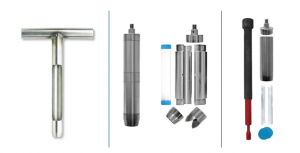Testing
Section 8.2 - 8.9 content text (only) Appendix C as A SCROLLING DOCUMENT!!!
Mention training courses
Soil Characterization Testing[edit]
The soil component of an LID BMP contributes substantially to its stormwater treatment performance and overall function. If the soil is overly compacted or very finely textured, it may drain too slowly. If the soil is highly organic or contains excessive amounts of chemical fertilizer it may contribute to nutrient loads to receiving waters rather than reduce them. If the soil is too shallow it may not provide adequate treatment of contaminated stormwater or may not support healthy vegetation. Whether it be the engineered filter media of bioretention cells, the growing media of green roofs or the topsoil of enhanced swales, vegetated filter strips and soil amendment areas, it is important that the soil provide a healthy growing environment for plantings while being within design specifications for key parameters specific to the type of BMP.
It is most important to sample and test soil characteristics as a part of Construction and Assumption inspections, to confirm the BMP has been constructed with materials that meet design specifications and that installation of the soil component is acceptable. Testing to confirm that the material meets quality specifications (i.e., particle-size distribution, organic matter, pH, cationic exchange capacity, nutrients and soluble salts) needs to be completed prior to it being delivered to the construction site. Testing to confirm that installation of the soil component is acceptable (i.e., depth and compaction) should be performed after the installed material has been allowed to settle for at least two (2) weeks, and prior to planting.
Sampling and testing is also recommended as a part of Verification inspections, to determine if the BMP is being adequately maintained and if soil characteristics are still within acceptable ranges. It may also be done as part of Forensic inspection and Testing (FIT) work to help diagnose the cause of poor vegetation cover, drainage or treatment performance and decide on corrective actions.
LID BMP Type |
Soil Characteristic |
Acceptance Criteria* |
Test | |
|---|---|---|---|---|
| Bioretention/Bioswales/Dry swales | ||||
| Texture** | Loamy Sand or Sandy Loam; 70 to 88% sand-sized particles; 12 to 30% silt- and clay-sized particles; <20% clay-sized particles. | Particle-Size Distribution (PSD), or % Sand/Silt/Clay (i.e., Soil Texture) plus Sand Fraction | ||
| Organic Matter (OM) | 3 to 10% by dry weight** | Walkley-Black method when OM <7.5% or Loss On Ignition (LOI) method when OM ≥7.5%*** | Inlet | |
| Inlet/Flow Spreader Structural Integrity | x | x | x | |
| Inlet/Flow Spreader Structural Integrity | x | x | x | x |
| Pretreatment sediment accumulation | x | x | x | |
| Inlet erosion | x | x | ||
| Perimeter | ||||
| BMP dimensions | x | x | x | |
| Side slope erosion | x | x | ||
| Surface ponding area | x | x | x | |
| Filter Bed | ||||
| Standing water | x | x | x | |
| Trash | x | x | ||
| Filter bed erosion | x | x | ||
| Mulch depth | x | x | x | x |
| Filter bed sediment accumulation | x | x | x | |
| Surface ponding depth | x | x | x | |
| Filter bed surface sinking | x | x | x | |
| Check dams | x | x | x | x |
| Planting Area | ||||
| Vegetation cover | x | x | x | x |
| Vegetation condition | x | x | ||
| Vegetation composition | x | x | x | |
| Outlet | ||||
| Monitoring well condition | x | x | x | x |
| Sub-drain/Perforated pipe obstruction | x | x | ||
| Overflow outlet obstruction | x | x | x | x |

Component |
Indicators |
Construction Inspection |
Assumption Inspection |
Routine Operation Inspection |
Verification Inspection | |
|---|---|---|---|---|---|---|
| Testing Indicators | ||||||
| Soil characterization testing | x | x | (x) | |||
| Sediment accumulation testing | x | x | x | x | ||
| Surface infiltration rate testing | x | (x) | ||||
| Natural or simulated storm event testing | x | (x) | ||||
| Continuous monitoring | x | (x) | ||||
| Note: (x) denotes indicators to be used for Performance Verification inspections only (i.e., not for Maintenance Verification inspections) | ||||||
Sediment Accumulation Testing[edit]
Surface Infiltration Rate Testing[edit]
Natural or Simulated Storm Event Testing[edit]
Continuous Monitoring[edit]
Green Roof Irrigation System Testing[edit]
Green Roof Leak Detection Testing[edit]
Cistern Pump Testing[edit]
References[edit]
- ↑ STEP. 2016. Low Impact Development Stormwater Management Practice Inspection and Maintenance Guide. https://sustainabletechnologies.ca/app/uploads/2016/08/LID-IM-Guide-2016-1.pdf